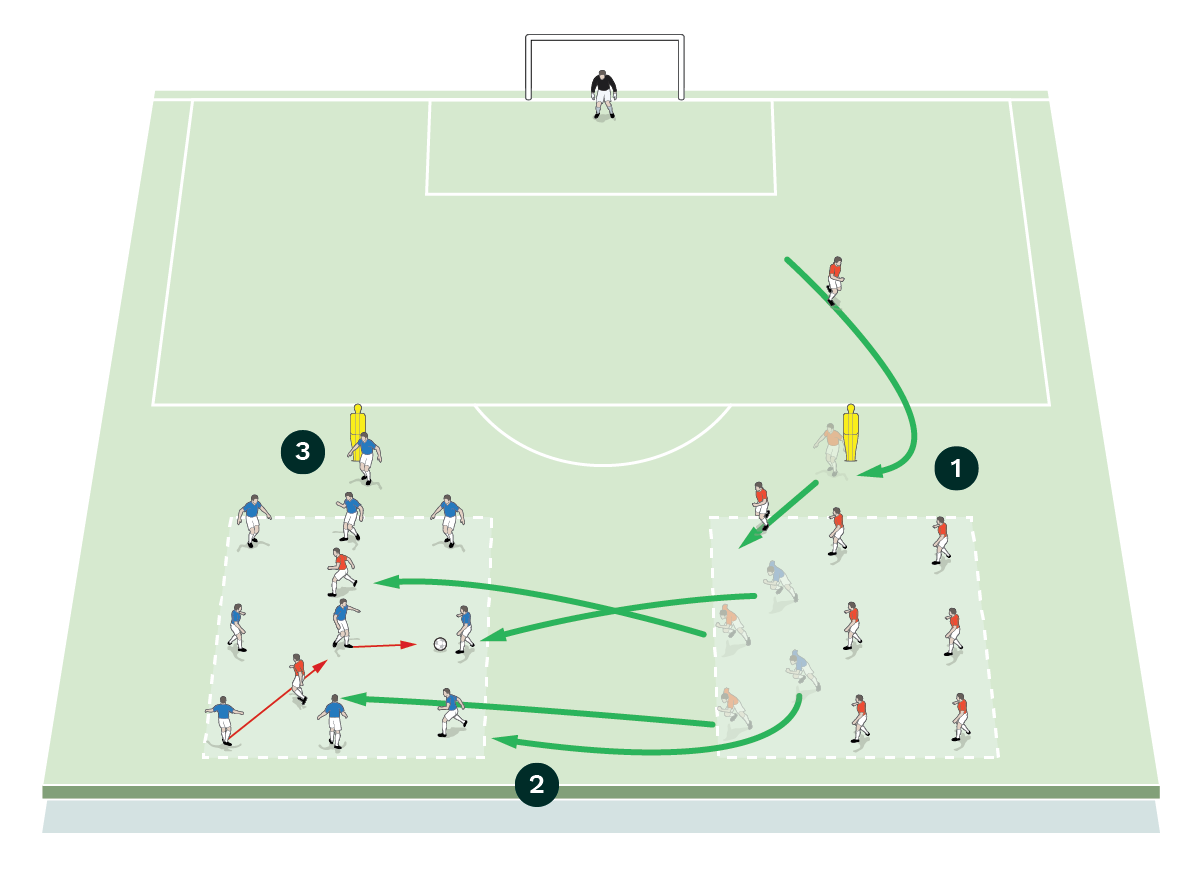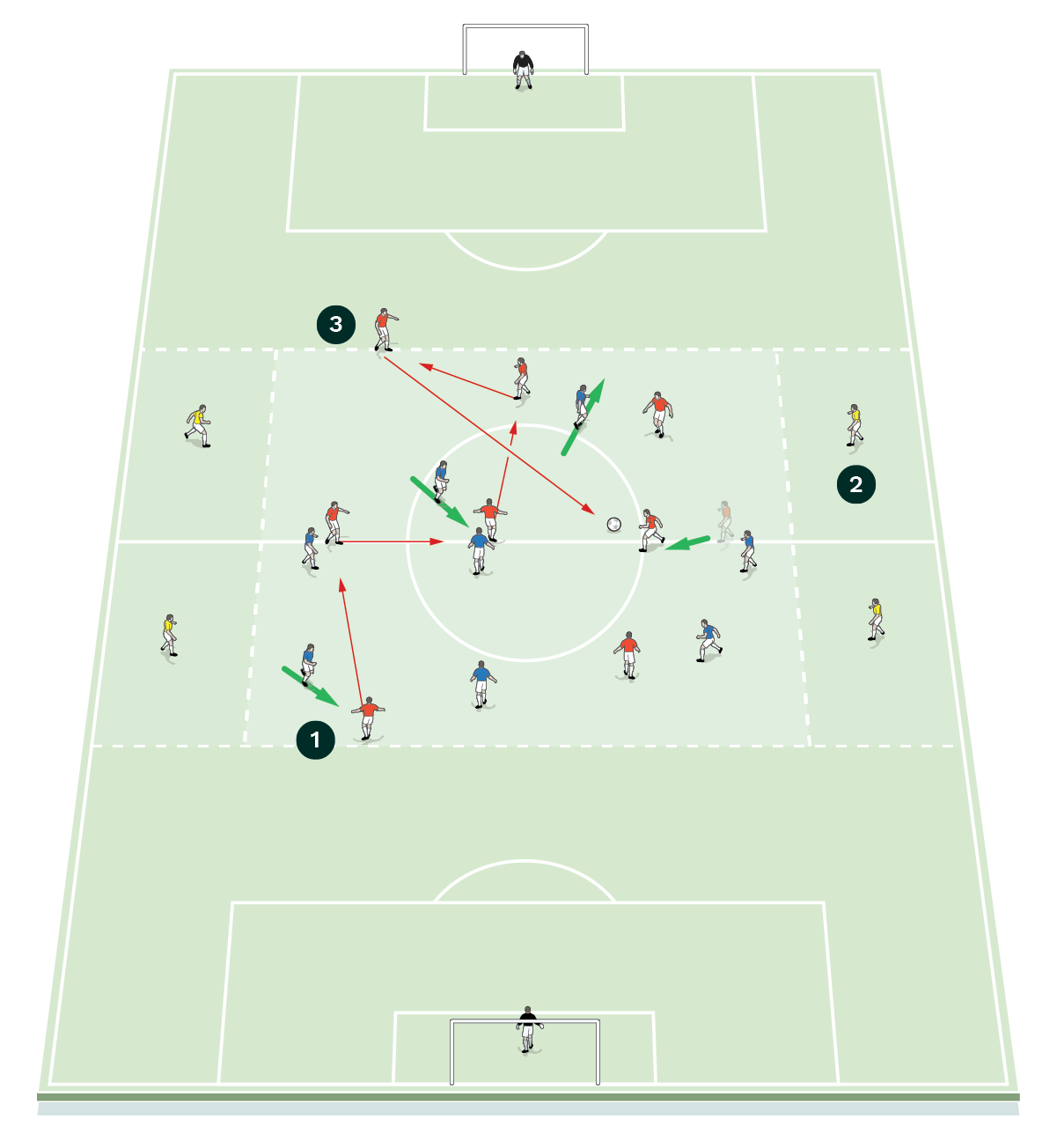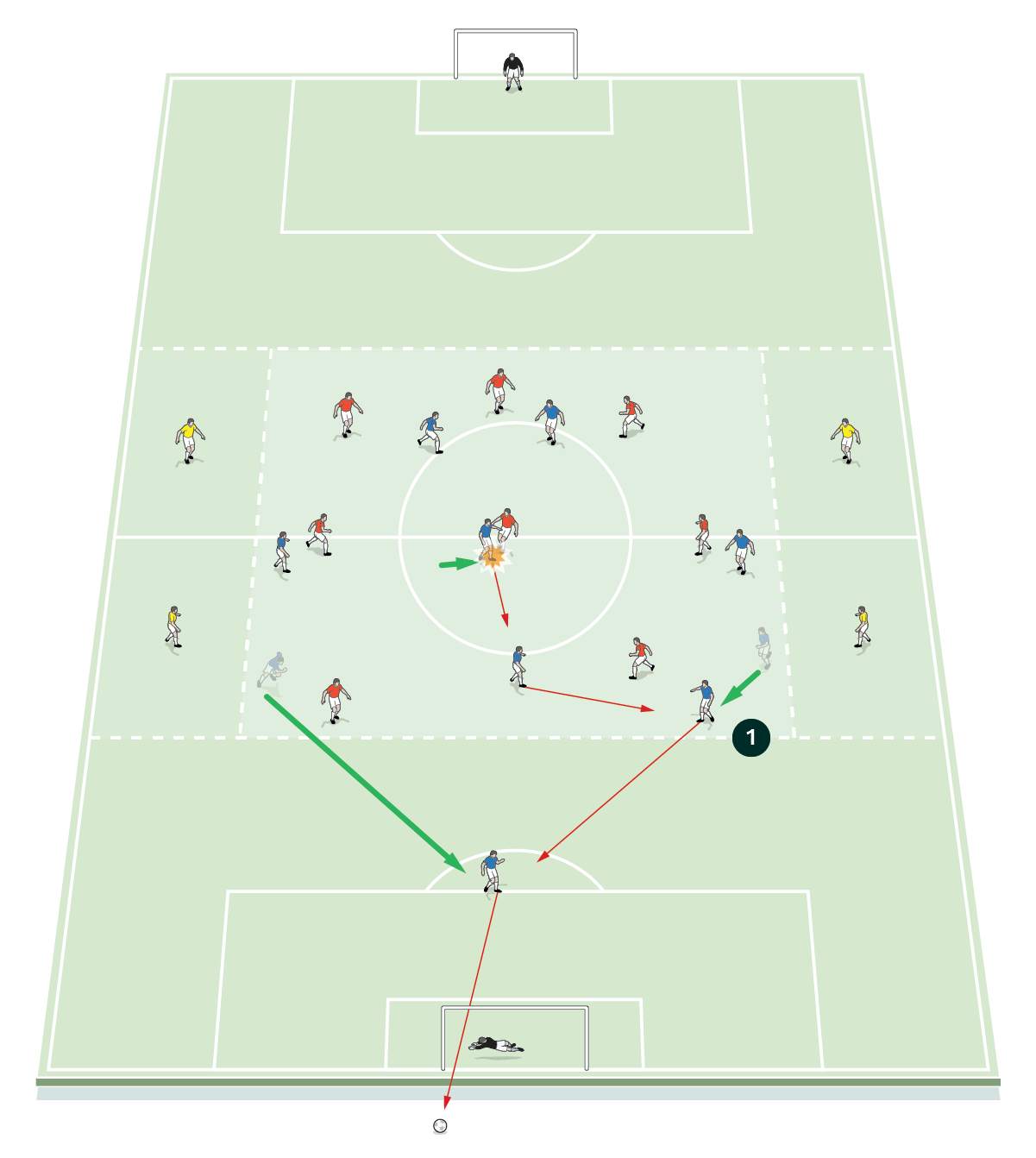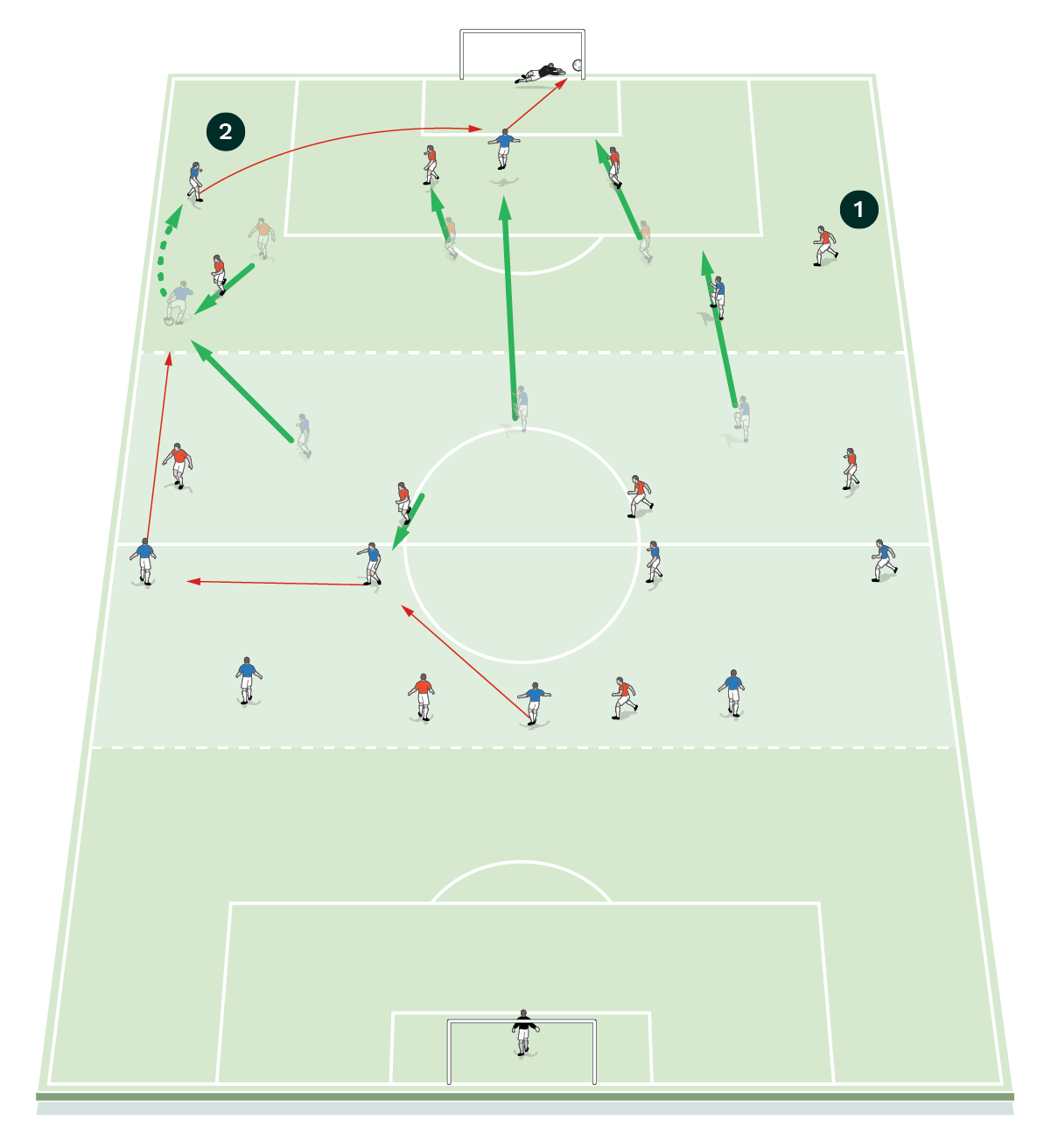Forward runs to break a defensive line

| Area | Up to full pitch |
| Equipment | Balls, bibs, cones, 2 mannequins, 2 full size goals |
| No. of Players | 20 players + 2 goalkeepers |
| Session Time | Breakout possession boxes: 16mins Midfield breakout: 20mins 11v11 game: 20mins |
This session promotes forward runs from all positions on the pitch: runs off the ball, third man runs, one-twos to break the defensive line and also forward runs to support a forward pass.
It promotes risk taking in possession and working on the recognition and timing of forward runs, whilst also practising the execution of the pass. Players receive numerous opportunities to create and score goals with plenty of realistic decision making opportunities.
This session is perfect for reinforcing how we want to break down a defensive line and we can adjust it based on our game plan and shape. We can also adjust it based on the opposition’s tactics and formation, regardless of whether they play with a back four or a back five, for instance, or a high line or a deep block.
The progression of the session leads the players towards what they are likely to experience on a game day.
This would be a squad session run towards the end of the week when we look at our attacking play. Typically we would use 18 to 20 outfield players to create realistic situations.
“Players receive numerous opportunities to create and score goals with plenty of realistic decision making opportunities”
BREAKOUT POSSESSION BOXES
After a warm-up [not shown], we would typically begin the session with an activity focused on breaking out of possession boxes to score. We set up a playing area on the final third of the pitch with a goal and a goalkeeper in their usual positions. Two 10-yard boxes are set up five yards out from the penalty area, as shown, and we position a mannequin two yards in front of each square.
We’re using 20 outfield players split into two teams of 10. The blues start in the box on the left with nine players in the box and one attacker on the mannequin. The reds start in the box on the right with nine players in the box and they also have one attacker on the mannequin.
Play starts at the back of the box on the right with the reds in possession of the ball. Two blue players from the other box can enter the red box to defend and try to win possession, while the red team must work the ball from the back of the box to the front and into the attacker on the mannequin with a minimum of five passes. A red player makes a third man run from the box to receive the ball from the attacker and go through on goal, as shown [1a].
[1a]

- Play starts with the reds in possession at the back of the box
- Two blue players from the other box can enter the red box to defend
- The reds must work the ball from the back of the box into the attacker on the mannequin using at least five passes
- A red player makes a third man run out of the box to receive the ball from the attacker on the mannequin and go through on goal
“Players must remain composed against the pressure of the defenders and on achieving five passes be looking to play into the front players”
After the runner shoots, play resets and the red runner switches positions with the red attacker on the mannequin. The two blue defenders return to their box and play then restarts with the blues in possession in the box on the left. Two red defenders are sent into the blue box to become the defenders, while the blue team look to work the ball from the back of the box into the attacker on the mannequin, with a minimum of five passes, as shown [1b].
[1b]

- After the runner shoots, play resets and the red runner switches positions with the red attacker on the mannequin
- The two blue defenders return to their box and two red defenders are sent into the blue box to try to win the ball
- Play restarts with the blues now looking to work the ball from the back of the box into the attacker on the mannequin, using a minimum of five passes
Players must remain composed against the pressure of the defenders and on achieving five passes be looking to play into the front players, either by having a positive first touch to set up the forward pass or by setting a team mate who can then play forward on one touch if possible.
Players can often miss the opportunity to play forwards due to a desire to maintain possession. Players providing the third man run off the ball must also be mindful not to attack the space too early. We are looking for explosive support after the pass has been made.
MIDFIELD BREAKOUT
We set up on a full pitch split into three zones with a full size goal and a goalkeeper at each end. The lines between the zones act as offside lines. The middle zone is also divided into three sections in line with the penalty area, creating a wide channel on each side.
We’re using 20 outfield players split into a red team of eight, a blue team of eight and four yellow floaters who play for the team in possession. The red team and the blue team both start in an 8v8 in the central block of the middle zone, while two yellows start in each wide channel of the middle zone, as shown.
The red team begins in possession and they look to play the ball from one end of the middle zone to the other, without the blues getting a touch on the ball. If the blues get a touch, the reds must reset and start again. The reds score a point every time they transfer the ball across the middle zone, as shown [2a].
[2a]

- The reds look to play the ball from one end of the middle zone to the other, without the blues getting a touch on the ball. If the blues get a touch, the reds must start again
- The yellows are wide floaters who play for the team in possession
- The reds score a point every time they transfer the ball from one end of the middle zone to the other
If the blue team wins possession, they must attack either of the goals by playing the ball to a runner and beating the offside trap, as shown [2b].
[2b]

- If the blues win possession, they must attack either goal by playing the ball to a runner and beating the offside trap
We would play in blocks of four minutes and then the two 8v8 teams would swap roles. As a progression the attacking team can now send a wing back (one of the yellow floaters) and two runners into the final third to try to score, while the defending team can send a defender into the final third to try to win the ball back, as shown [2c].
[2c]

- At the end of the allotted time, the teams swap roles. The reds are now the attacking team
- As a progression, the attacking team can send two runners into the final third to try to score
- The team in possession can also send a wing back (one of the yellow floaters) to join the attack in the final third
- The defending team can send a defender into the final third to try to win the ball back
Players can be stretched further by restricting the breakout forward through pass to be played with a first touch.
11v11 GAME
We now transfer the principles developed in the earlier activities into some match preparation for our up-coming game.
We set up on a full pitch split into three zones with a full size goal and a goalkeeper at each end. The lines between the zones act as offside lines. We’re using 20 outfield players split into two teams of 10. Both teams start in the middle zone. In this instance, the red team is set up in a 4-4-2 formation with a mid-block and two centre forwards, while the blue team is set up in an attacking 3-4-3 formation. The blues start in possession and they look to work the ball from one end of the middle zone to the other before playing a ball through to an attacker, who makes a run to receive and then looks to score, as shown [3a].
[3a]

- The red team is set up in a 4-4-2 formation with a mid-block and two centre forwards
- The blue team is set up in an attacking 3-4-3 formation and they look to work the ball from one end of the middle zone to the other before playing a through ball into the final third for an attacker to run onto
- The attacker runs onto the ball and then then looks to score
- The reds try to win the ball back but the red centre forwards are not allowed to defend
The reds look to win the ball back but the centre forwards are not allowed to defend.
If the red team wins the ball back, their centre forwards now come into play. The reds win a point by regaining possession, playing the ball into a centre forward, and then retaining possession with support, as shown [3b].
[3b]

- If the red team wins the ball, their centre forwards now come into play. The reds can win a point by regaining possession, playing the ball into a centre forward, and then retaining possession with support
As a progression, the red back four can start in their defensive third so that they can track runs and defend realistically. It is also to represent a deep block. The blues must look to break through the defensive line with less space in behind, as shown [3c].
[3c]

- As a progression, the red back four can start in their defensive third
- The blues must now work the ball through the middle third, and past the red defensive line with less space in behind
Alterations can be made to the formations so they represent what we are likely to face in our next match.
Editor's Picks
Attacking transitions
Deep runs in the final third
Using the goalkeeper in build-up play
Intensive boxes drill with goals
Penetrating the final third
Creating and finishing
My philosophy
Pressing initiation
Compact team movement
Coaches' Testimonials

Alan Pardew

Arsène Wenger

Brendan Rodgers

Carlos Carvalhal

José Mourinho

Jürgen Klopp

Pep Guardiola

Roy Hodgson

Sir Alex Ferguson

Steven Gerrard
Coaches' Testimonials

Gerald Kearney, Downtown Las Vegas Soccer Club

Paul Butler, Florida, USA

Rick Shields, Springboro, USA

Tony Green, Pierrefonds Titans, Quebec, Canada
Join the world's leading coaches and managers and discover for yourself one of the best kept secrets in coaching. No other training tool on the planet is written or read by the calibre of names you’ll find in Elite Soccer.
In a recent survey 92% of subscribers said Elite Soccer makes them more confident, 89% said it makes them a more effective coach and 91% said it makes them more inspired.
Get Monthly Inspiration
All the latest techniques and approaches
Since 2010 Elite Soccer has given subscribers exclusive insight into the training ground practices of the world’s best coaches. Published in partnership with the League Managers Association we have unparalleled access to the leading lights in the English leagues, as well as a host of international managers.
Elite Soccer exclusively features sessions written by the coaches themselves. There are no observed sessions and no sessions “in the style of”, just first-hand advice delivered direct to you from the coach.









